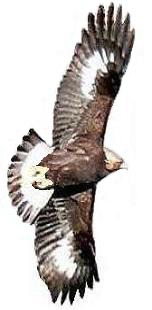Cooper's Hawk
(Accipiter cooperii)
Migration Timeframe:
Migration for Cooper's Hawks begins in early
September, increasing as the month progresses and
peaking by mid-October. Numbers slowly decline
during the second part of October and all through
November. Very few are counted in December.
Juvenile birds leave first, and females precede
males of each by a minimum of several days, although
with some overlap. The average overall distance
traveled is probably greater for females than
males, yet males will sometimes travel far south.
|
Year |
Peak Week |
Avg |
|
2002-2007 |
Oct 20-26 |
114 |
|
Year |
Peak Week |
Count |
|
2008 |
Oct 13-19 |
71 |
|
Year |
Earliest
Obs |
Count |
Year |
Latest
Obs |
Count |
|
2002-2007 |
Aug 31 2007 |
2 |
2002-2007 |
Nov 14 2006 |
1 |
|
2008 |
Sep 09 |
2 |
2008 |
Nov 21 |
3 |
Where to Watch:
All accipiters tend to pass through The Cliff area
along the tree lines or sneaking along the cliff.
Their flight level is often lower compared to most
of the other raptors. The best views of Cooper's
Hawks are usually right at "Sharpie Alley" (just
south of the ravine) much like the Sharpies. Farther
north (past the intersection at Dexter Line)
Cooper's Hawks can be seen cruising and hunting
along the tree lines to the right and left of the
fields to the east
High Counts:
There were no new records set for Cooper's Hawk for the 2008 season.
|
1-Year |
Count |
1-Month |
Count |
|
2007 |
637 |
Oct 2003 |
480 |
|
1-Day |
Count |
1-Hour |
Count |
|
Oct 06 1986 |
276 |
Oct 25 2006 |
27 |
Yearly Totals:
The 2008 yearly total for Coops fell well short of both the 5-yr and
the 10-year averages (averages are based on 1998-2007 and
2003-2007 counts).
|
Year |
Count |
Year |
Count |
Year |
Count |
|
1995 |
402 |
2000 |
239 |
2005 |
584 |
|
1996 |
392 |
2001 |
263 |
2006 |
630 |
|
1997 |
423 |
2002 |
395 |
2007 |
637 |
|
1998 |
156 |
2003 |
583 |
2008 |
280 |
|
1999 |
359 |
2004 |
433 |
2009 |
N/A |
|
10-Yr Avg |
5-Yr Avg |
|
428 |
573 |
Interesting Facts:
-
Cooper's Hawk
are sexually dimorphic with marginal or no overlap.
-
Males are nearly always smaller than females.
-
Cooper's Hawks (and most accipiters in general) are
not seen in any numbers until the air has warmed up a bit
and currents are prevalent, typically around 0900 hours...with
Cooper's usually starting to move later in the morning than Sharpies
-
Some Cooper's Hawks winter in Ontario and if you have bird feeders
you might spot one coming to get a small bird as a meal.
-
Southern latitude birds are usually sedentary, while Northern
birds may stay in their territories or move farther south
from breeding and natal areas.
-
Cooper's Hawks will generally shun any long flights over
open water, but they may make “ short ” water crossings,
(e.g. Florida Keys).
-
Some migrants winter south of the Mexican border traveling as
far as the southern parts of Central America and into
Columbia
|
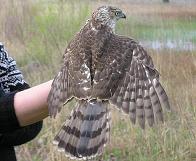
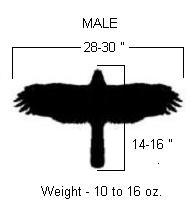
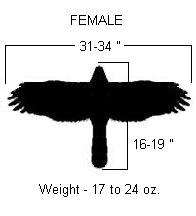
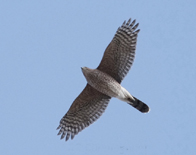
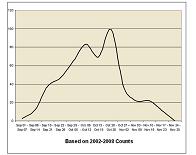
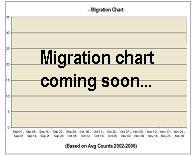
|
